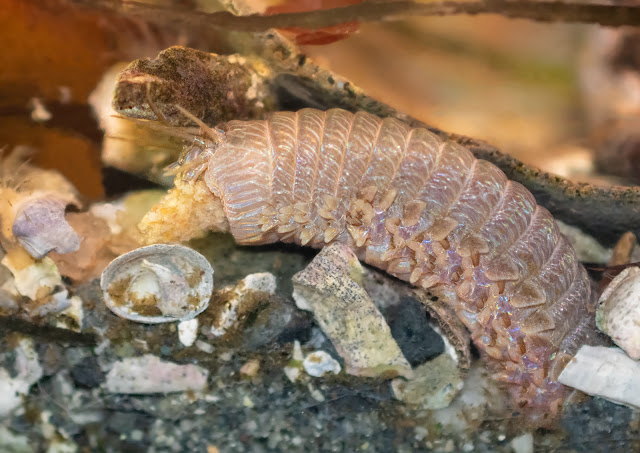In the sand at the bottom of my aquarium, there lives a worm. He's a shy critter, and I used to only see him when I cleaned the sand, sifting through it thoroughly. Even then, all I usually saw of him was his quickly disappearing curves. He moves fast, even in dense sand.
But he's been growing. The last time I caught him, he measured about 6 inches long; he can easily grow to four times that. And he's hungry. So hungry he's forgotten to be shy. When I drop shrimp pellets into the tank for the crabs and hermits, he comes out to get his share, quickly retreating into the sand once he's got a mouthful. But he comes back for more; it takes a lot of food for his long, fat body.
I tempted him with pellets right up against the glass.
He's a segmented worm. Each segment has two sets of leafy "paddles" which help with movement, and also serve for respiration. On the head he has two fat palps and four sets of tentacles, two small antennae, a huge mouth, and four eyes. With all that sensory equipment, he responds instantly to any movement, or change in lighting. And he smells the food from far away, under the sand.
And his coat is shiny, pink, and iridescent. He glows!
 |
Found a pellet, and opened that enormous mouth. One gulp, and it's gone.
|
~~~~~~~~~~~~~~~~~~~~~~
En la arena en el fondo de mi acuario, vive un anélido, un poliqueto Nereis. Es una criatura bastante tímida; acostumbraba verlo solamente cuando hacía una limpieza completa del tanque, removiendo y lavando la arena. Aún así, normalmente apenas lograba un vistazo mientras se enterraba con toda prisa. Hasta en arena apretada, se mueve rapidamente.
Pero ha estado creciendo. La última vez que lo saqué de la arena, medía más o menos 15 centímetros. (Puede crecer hasta cuatro veces ese tamaño.) Y tiene hambre. Tanta hambre le motiva a atreveserse a salir a la vista en busca de comida. Cuando les doy de comer a los cangrejos y ermitaños, que comen bolitas de camarón, el poliqueto las huele y sube a capturar su cena. Agarra una bolita, y se retira a su hoyo en la arena para tragarla, pero pronto sale a buscar más. Ese cuerpo largo y gordo requiere muchas calorías.
Es un anélido segmentado; en cada segmento del cuerpo lleva dos pares de patas en forma de hojas; estos le sirven para movilizarse, y además contienen su sistema respiratorio. En la cabeza lleva dos palpos, órganos de tacto, cuatro tentáculos, dos antenitas, cuatro ojos, y una boca enorme.
Y su piel es de un color rosa, brillosa, e iridiscente. ¡Resplandece!



Do these worms hunt? I know that some of them have teeth, so I wonder hunger could drive this worm to seek nutrition from the other living inhabitants.
ReplyDeleteThese worms are mainly algae eaters. It is said that the jaws are mostly used to defend their territory, although they can eat other animals. (https://www.centralcoastbiodiversity.org/giant-clam-worm-bull-nereis-brandti-nereis-virens.html)
ReplyDeleteHowever, I saw today when the worm was out collecting shrimp pellets (not algae), he came nose to nose with one of the smaller hermits, smaller than the worm's diameter. The hermit hit him on the nose, and he backed off. A second time, and he retreated completely into the sand, and when he ventured out again would not go near the hermit.
Other intertidal worms are carnivorous, and predatory.